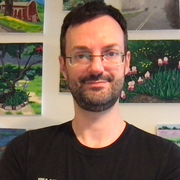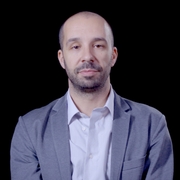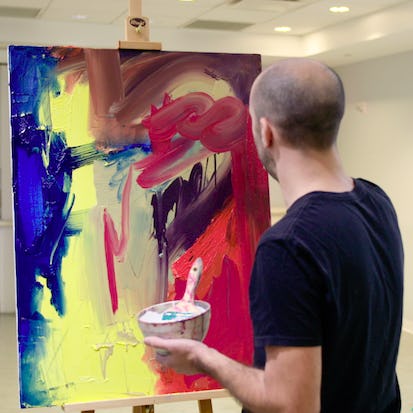- Level Foundation
- Duration 27 hours
- Course by The Museum of Modern Art
-
Offered by

About
Want to know how some of the 20th century's most celebrated artists made abstract paintings? This course offers an in-depth, hands-on look at the materials, techniques, and thinking of seven New York School artists, including Willem de Kooning, Yayoi Kusama, Agnes Martin, Barnett Newman, Jackson Pollock, Ad Reinhardt, and Mark Rothko. Through studio demonstrations and gallery walkthroughs, you'll form a deeper understanding of what a studio practice means and how ideas develop from close looking, and you'll gain a sensitivity to the physical qualities of paint. Readings and other resources will round out your understanding, providing broader cultural, intellectual, and historical context about the decades after World War II, when these artists were active. The works of art you will explore in this course may also serve as points of departure to make your own abstract paintings. You may choose to participate in the studio exercises, for which you are invited to post images of your own paintings to the discussion boards, or you may choose to complete the course through its quizzes and written assessments only. Learners who wish to participate in the optional studio exercises may need to purchase art supplies. A list of suggested materials is included in the first module. Learning Objectives: Learn about the materials, techniques, and approaches of seven New York School artists who made abstract paintings. Trace the development of each artist's work and studio practice in relation to broader cultural, intellectual, and historical contexts in the decades after World War II. Hone your visual analysis skills. Use each artist's works as a point of departure for making your own abstract paintings.Modules
Part I: History and Context
1
Videos
- 1.2 Introduction to the New York School
1
Readings
- 1.1 Introduction to the Course
Part II: In the Studio
5
Videos
- 1.3 In the Studio: How to Stretch a Canvas
- 1.4 In the Studio: How to Stretch a Large Canvas (Optional)
- 1.5 In the Studio: Priming the Canvas
- 1.6 In the Studio: Oil Paint
- 1.7 In the Studio: Acrylic Paint
Part III: Read & Review
1
Assignment
- Introduction
1
Discussions
- Artist communities
5
Readings
- 1.8 Supply List
- 1.9 Readings & Resources
- 1.10 Glossary
- Tell Us About You
- MoMA resources: podcasts, art vocabulary, Magazine, and YouTube channel
Part I: Meet the Artist
2
Readings
- 2.1 Introduction to Barnett Newman
- 2.2 Slideshow: A Career in Eight Works
Part II: Look & Learn
5
Videos
- 2.3 In the Studio: Materials & Techniques of Barnett Newman
- 2.4 In the Galleries: A Closer Look at Onement, I, 1948
- 2.5 In the Galleries: A Closer Look at The Wild, 1950
- 2.6 In the Galleries: A Closer Look at Vir Heroicus Sublimis, 1950-51
- 2.7 Collector Ben Heller on Vir Heroicus Sublimis, 1950-51
Part III: Read & Review
1
Assignment
- Barnett Newman
2
Discussions
- Painting and affect
- Barnett Newman studio exercise
2
Readings
- 2.8 Readings & Resources
- 2.9 Glossary
Part I: Meet the Artist
2
Readings
- 3.1 Introduction to Willem de Kooning
- 3.2 Slideshow: A Career in Eight Works
Part II: Look & Learn
5
Videos
- 3.3 In the Studio: Materials & Techniques of Willem de Kooning
- 3.4 In the Studio: Materials & Techniques of Willem de Kooning Part 2
- 3.5 In the Galleries: A Closer Look at Woman I, 1950-52
- 3.6 Curator John Elderfield on Excavation, 1950
- 3.7 Curator John Elderfield on Pirate (Untitled II), 1981
Part III: Read & Review
1
Assignment
- Willem de Kooning
2
Discussions
- Abstraction and likeness
- Willem de Kooning Studio Exercise
2
Readings
- 3.8 Readings & Resources
- 3.9 Glossary
Part I: Meet the Artist
2
Readings
- 4.1 Introduction to Jackson Pollock
- 4.2 Slideshow: A Career in Eight Works
Part II: Look & Learn
10
Videos
- 4.3 In the Studio: Materials & Techniques of Jackson Pollock
- 4.4 In the Galleries: A Closer Look at The She-Wolf, 1943
- 4.5 In the Galleries: A Closer Look at Full Fathom Five, 1947
- 4.6 In the Galleries: A Closer Look at One: Number 31, 1950
- 4.7 In the Galleries: A Closer Look at Echo: Number 25, 1951
- 4.8 In the Galleries: A Closer Look at Easter and the Totem, 1953
- 4.9 In the Galleries: A Closer Look at White Light, 1954
- 4.10 Curator Ann Temkin on The She-Wolf, 1943
- 4.11 Collector Ben Heller on One: Number 31, 1950
- 4.12 Curator Ann Temkin on Easter and the Totem, 1953
Part III: Read & Review
1
Assignment
- Jackson Pollock
2
Discussions
- Radical reinvention
- Jackson Pollock Studio Exercise
3
Readings
- 4.13 Readings & Resources
- 4.14 Glossary
- Mid-course survey
Part I: Meet the Artist
2
Readings
- 5.1 Introduction to Mark Rothko
- 5.2 Slideshow: A Career in Eight Works
Part II: Look & Learn
7
Videos
- 5.3 In the Studio: Materials & Techniques of Mark Rothko
- 5.4 In the Galleries: A Closer Look at Slow Swirl at the Edge of the Sea, 1944
- 5.5 In the Galleries: A Closer Look at No. 3/No. 13, 1949
- 5.6 In the Galleries: A Closer Look at No. 10, 1950
- 5.7 Curator Ann Temkin and the artist's son Christopher Rothko on Slow Swirl at the Edge of the Sea, 1944
- 5.8 The artist's son Christopher Rothko on No. 10, 1950
- 5.9 The artist's son Christopher Rothko on No. 16 (Red, Brown, and Black), 1958
Part III: Read & Review
1
Assignment
- Mark Rothko
2
Discussions
- The power of color
- Mark Rothko Studio Exercise
3
Readings
- *Advanced Planning for Module 7: In the Studio: Materials & Techniques of Ad Reinhardt
- 5.9 Readings & Resources
- 5.10 Glossary
Part I: Meet the Artist
2
Readings
- 6.1 Introduction to Agnes Martin
- 6.2 Slideshow: A Career in Eight Works
Part II: Look & Learn
4
Videos
- 6.3 In the Studio: Materials & Techniques of Agnes Martin
- 6.4 A Closer Look at Friendship, 1963
- 6.5 A Closer Look at Untitled No. 1, 1981
- 6.6 Curator Leah Dickerman on The Tree, 1964
Part III: Read & Review
1
Assignment
- Agnes Martin
2
Discussions
- Abstract Expressionism and Minimalism
- Agnes Martin Studio Exercise
2
Readings
- 6.7 Readings & Resources
- 6.8 Glossary
Part I: Meet the Artists
2
Readings
- 7.1 Introduction to Ad Reinhardt
- 7.2 Slideshow: A Career in Eight Works
Part II: Look & Learn
4
Videos
- 7.3 In the Studio: Materials & Techniques of Ad Reinhardt
- 7.4 In the Galleries: A Closer Look at Number 107, 1950
- 7.5 In the Galleries: A Closer Look at Abstract Painting, 1963
- 7.6 Curator Ann Temkin and Ad Reinhardt on Abstract Painting, 1957
Part III: Read & Review
1
Assignment
- Ad Reinhardt
2
Discussions
- "Art is free"
- Ad Reinhardt Studio Exercise
2
Readings
- 7.7 Readings & Resources
- 7.8 Glossary
Part I: Meet the Artist
2
Readings
- 8.1 Introduction to Yayoi Kusama
- 8.2 Slideshow: A Career in Eight Works
Part II: Look & Learn
4
Videos
- 8.3 In the Studio: Materials & Techniques of Yayoi Kusama
- 8.4 A Closer Look at No. F, 1959
- 8.5 A Closer Look at Violet Obsession, 1994
- 8.6 Curator Laura Hoptman on Accumulation No. 1, 1962
Part III: Read & Review
1
Assignment
- Yayoi Kusama
2
Discussions
- Working across mediums
- Yayoi Kusama Studio Exercise
4
Readings
- 8.6 Readings & Resources
- 8.7 Glossary
- Funding & Credits
- End-of-course survey
Lesson Track 1
1
Peer Review
- Final Project: Visual analysis essay
Lesson Track 2
1
Peer Review
- Final Project: Studio exercise and visual analysis essay
Auto Summary
Explore the captivating world of postwar abstract painting with Coursera's "In the Studio: Postwar Abstract Painting." Delve into the techniques and materials used by seven renowned New York School artists, including Jackson Pollock and Mark Rothko. This foundational course combines studio demonstrations, gallery walkthroughs, and in-depth readings, offering a comprehensive understanding of the artistic practices and historical contexts of the post-WWII era. Ideal for art enthusiasts and aspiring painters, the course spans 1620 minutes and includes optional studio exercises, with a starter subscription available. Join now to enhance your visual analysis skills and create your own abstract art.

Alex Roediger

Corey D'Augustine

